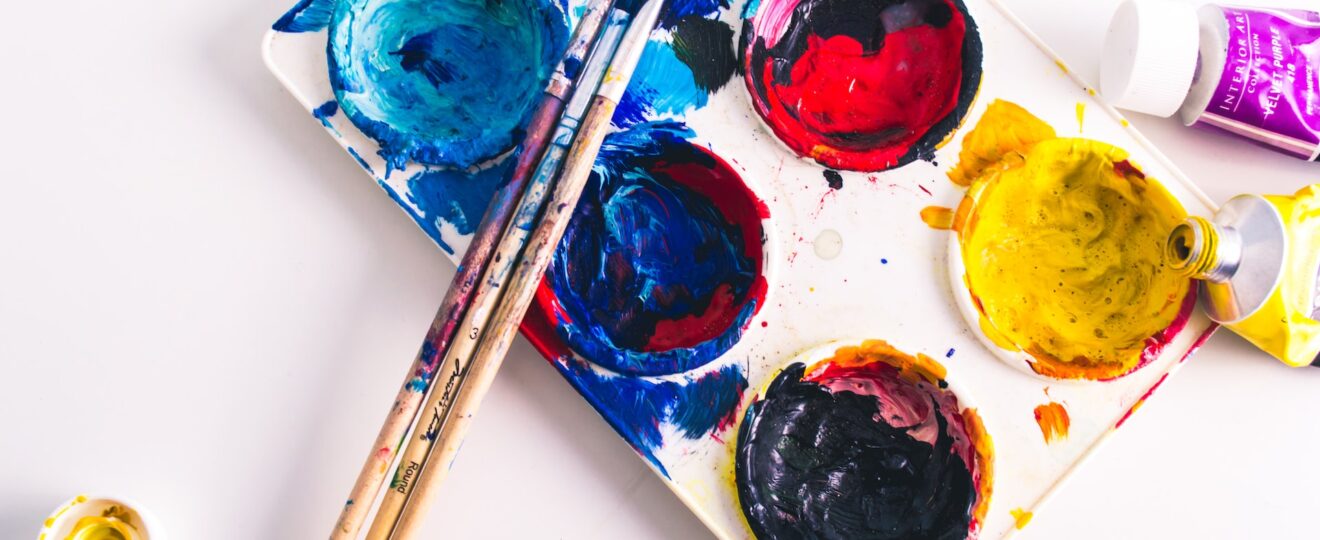Acrylic painting is a versatile and popular medium for creating beautiful works of art.
While painting with acrylics can be intimidating for some, it can be an incredibly rewarding and therapeutic hobby for others.
With the right tips, techniques and guidance, anyone can create amazing pieces with acrylic paints.
In this article, we’ll share 35 essential tips that will help both beginners and experienced artists get the most out of their acrylic painting.
From selecting the right supplies and preparing your canvas to advanced techniques, we’ll share everything you need to know to paint like a professional.
- Select The Right Supplies
One of the most important tips for painting with acrylics is to make sure you have the right supplies.
Paints, brushes, palettes and other supplies come in a variety of types and sizes, so it’s important to understand what you need and what works best for your individual needs.
Acrylic paint is available in many different brands and price ranges, so do your research and find what works best for you.
When it comes to brushes, choose a variety that is appropriate for the type of painting you plan to do – from flat brushes for fine details and short-haired brushes for heavy applications.
- Prepare Your Canvas
Before you start painting, it’s important to prepare your canvas.
If you’re using a pre-primed canvas, make sure it is totally dry and clear of any dust or debris.
If you’re using a raw canvas, you’ll need to prime it with an appropriate primer.
An acrylic gesso is a great choice, as it helps to seal the canvas and makes it easier to paint on. Once your canvas is ready, you can start painting.
- A Brief Overview of Color Theory
Color theory is an essential element of painting, and it’s important to have a basic understanding of how colors interact and behave.
Color theory teaches us how to use colors to create harmony and contrast, and to express a certain mood or emotion.
Learning and understanding the basics of color theory and how it applies to painting can be a great asset for all artists.
- Understand Acrylic Drying Times
One of the great benefits of painting with acrylics is that the paint dries quickly.
When painting with acrylics, it’s important to be aware of the different drying times and how to work with them.
Generally, acrylics can take anywhere from 15 minutes to an hour to dry, depending on how thick the paint is and how much medium you’ve used.
Knowing how long it takes for your paints to dry is essential for making sure you don’t overwork your piece or ruin the result with a change of color.
- Choose Colors That Complement Each Other
When it comes to painting with acrylics, it’s important to choose colors that work together and complement each other.
One way to do this is to start with a limited palette and gradually add colors as your painting progresses.
Complimentary colors can also be used to create interesting color combinations and depth.
- Mix Your Colors
One of the best ways to get the colors you want is to mix them yourself.
Mixing colors is a great way to explore different colors and shades, and to create beautiful, subtle transitions.
It’s important to remember that the colors you mix won’t look the same wet as they do when they dry, so it’s best to mix more than you need and to test the colors on a separate sheet of paper before you apply them to your painting.
- Work in Layers
One of the most important tips for painting with acrylics is to work in layers.
When you paint in layers, you can slowly build up color, texture and depth over time.
This will help you to create realistic and beautiful results without sacrificing control or precision.
Begin with a lighter color and slowly build up darker shades and colors.
- Add Texture to Your Paintings
Adding texture to your paintings is a great way to create interesting and eye-catching results.
Acrylics are particularly versatile when it comes to adding texture, thanks to the medium’s ability to easily hold texture.
You can add texture with various tools, such as a palette knife, brushstrokes and even handprints.
- Use a Palette Knife
A palette knife is a great tool for adding texture, blending colors and creating an interesting effect in your painting.
A palette knife can be used for everything from blending colors to spreading thick layers of paint or creating textured effects.
Experiment with different sizes and shapes of palette knives to find what works best for you and your painting.
- Protect Your Painting
When your painting is finished, it’s important to take measures to protect it.
Acrylic paint is durable and resistant to fading, but it’s still important to protect it from dust and dirt.
You can spray your painting with a protective sealer and frame it behind glass to keep it in good condition for years to come.
- Use Texture Pastes
Texture pastes are a great way to add texture to your painting without having to use tools like a palette knife.
Texture pastes can be used to create a variety of textures and effects, from subtle to bold and from gritty to smooth.
Experiment with different types of texture pastes to find the look and effect you want.
- Use Gesso for a Professional Finish
Gesso is a great choice for achieving a professional finish with your painting.
It can be used to prime the canvas, to create a smooth, even surface for painting and to add texture and interest.
Acrylic gesso can also be used to create special effects, such as highlighting and blending.
- Use a Variety of Brushes
Having the right brushes is essential for achieving a professional-looking result with your painting. Invest in brushes of various sizes and shapes, and experiment with different materials such as sable, hog or synthetic.
You can also use different brush types and techniques, such as dry brushing and wet brushing, to create interesting effects in your painting.
- Add Drama with Contrast
Adding contrast to your painting is a great way to add drama and emphasis to certain elements.
This is a great technique for making certain parts of your painting stand out and creating a more dynamic composition.
Try varying the colors and values of the elements in your painting to create contrast, or use light and dark elements to achieve an interesting visual effect.
- Vary the Thickness of Your Paint
Varying the thickness of the paint can create interesting results and create an image with more depth and dimension.
You can thin out the paint with water or use a thicker, more opaque paint for a more dramatic effect.
Experiment with different thicknesses to find what works best for your painting.
- Experiment with Different Textures
Texturizing your painting can create an interesting visual effect and give your painting more depth.
You can use a variety of tools and techniques, such as a palette knife, texture pastes or stencils, to create different textures in your painting.
Experiment and be creative to find the perfect texture for your painting.
- Add Interest with Glazes
Glazes are a great way to add interest and depth to your painting.
Glazing involves applying thin layers of paint and medium to create an even, transparent layer that allows the colors beneath to show through.
Glazes can be used to create a range of interesting effects, from subtle highlights and shadows to bold colors and patterns.
- Use an Eraser
Using an eraser can be a great way to create texture, depth and interest in your painting.
An eraser can be used to erase areas of paint or to lightly blend colors.
Experiment with a variety of erasers to find the one that works best for your painting.
- Try Textured Paint
Textured paint can add a great visual effect to your painting.
You can buy textured paint in a variety of colors to create interesting textures and effects.
Alternatively, you can add texture to your paint yourself by mixing mediums, such as sand or glitter, into the paint.
- Use a Primer
Using a primer is a great way to ensure an even surface and help your colors pop.
Priming your canvas is an essential step for creating beautiful and professional-looking results.
Acrylic gesso is a good choice for priming your canvas, as it seals and prepares the canvas for painting.
- Use Contrasting Colors
Using contrasting colors can create an interesting visual effect and add more depth to your painting.
Contrasting colors can help to make certain elements of the painting stand out, and can help to create a dynamic composition.
Experiment with different color combinations to find the perfect contrast for your painting.
- Experiment With Colors
Experimenting with different colors is a great way to explore and discover the full potential of acrylic paints.
You can use a limited palette to create interesting color combinations, or you can mix your own colors to get the exact shade you want.
Try experimenting with different color combinations to see what works best for your painting.
- Take a Break
It’s important to take breaks while working on a painting.
Taking a break can help to prevent artist’s fatigue and can help you to come back to your painting with a fresh pair of eyes.
Stepping away from your painting can also help you to gain perspective, allowing you to make better decisions about your painting and make adjustments more easily.
- Paint with a Limited Palette
Painting with a limited palette is a great way to practice restraint and to focus on the importance of color in your painting.
A limited palette will also help to create a cohesive color scheme throughout the painting, making it look more professional.
- Keep a Sketchbook
Keeping a sketchbook is a great way to practice your painting and to experiment with different techniques and ideas.
Sketching and doodling can help to develop your style and improve your painting skills.
Keeping a sketchbook can also help you to come up with new ideas for paintings and can help you to brainstorm new perspectives and compositions.
- Learn Composition
Learning about composition is essential for creating beautiful and professional-looking paintings.
Composition refers to the way elements are arranged within a painting, and it is one of the most important aspects of a painting.
Learn the basics of composition, such as the rule of thirds, and practice using composition in your paintings.
- Create a Mock-up
Creating a mock-up is a great way to plan and organize your painting before you start.
You can use a variety of tools, such as a sketchbook or digital painting program, to create a mock-up of your painting.
This will help you to plan out the composition, colors and elements of your painting and will make it easier to achieve the result you want.
- Use Open Space
Using open space in your painting can help to create a sense of depth and can make your painting look more professional.
Open space refers to areas that are left free from color, texture and detail.
Open spaces allow the eye to rest and make certain elements of the painting stand out.
- Paint in Series
Paint a series of works instead of just one painting to make the most of your time.
Painting a series of works can make it easier to master a certain technique or style, and will give you a bigger portfolio to show off.
- Make a Plan
Make a plan before you start painting to ensure that you make the most of your time and achieve the results you want.
You can plan out the colors, elements and composition before you start painting, or you can create a detailed sketch with measurements if you need to.
- Take It Slow
It’s important to be patient and take your time while painting with acrylics.
Rushing or working too quickly can cause the paint to dry too fast or become too thick, which can ruin the result of your painting.
Take your time and plan out your painting before you start and make sure you take regular breaks to prevent artist’s fatigue.
- Paint from Photos
Painting from photos is a great way to practice your painting skills and to explore different techniques.
When painting from photos, practice to create more than an exact copy of the photo.
Try to make the painting your own, and be sure to stay true to your own unique style.
- Create Depth With Contrast and Value
Contrast and value are great ways to create depth and make your painting look more professional.
Contrast is created when different elements in the painting have different levels of color or tone, while value is created from the lightness or darkness of certain elements.
Experiment with contrast and value to give your painting more depth.
- Practice Perspective
Perspective is essential for creating realistic-looking paintings.
Learning and understanding perspective will help you to create more believable paintings, and will make the painting look more professional.
Practice perspective by drawing still lifes and landscapes to get a better understanding of how perspective works.
- Take Your Time and Have Fun
Above all, remember to take your time and have fun when painting with acrylics.
Don’t stress about making mistakes, as these can often lead to inspiring and unexpected results.
Experiment and have fun, and you’ll be sure to create beautiful works of art.
Conclusion
We hope these 35 essential tips have given you the knowledge and inspiration to paint like a professional with acrylic paints.
Remember to take your time and have fun, and you’ll be sure to create beautiful pieces that you can be proud of.
With the right supplies, techniques and practice, you too can create amazing and stunning works of art with acrylic paints.










